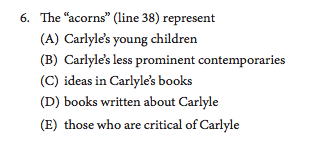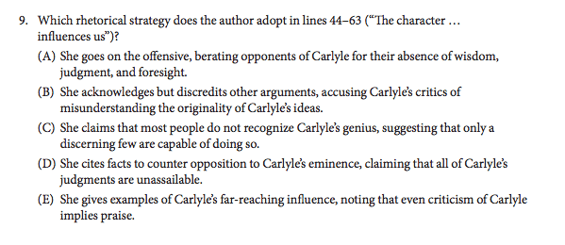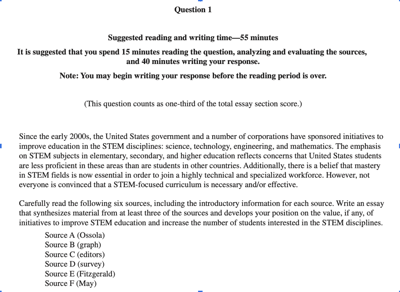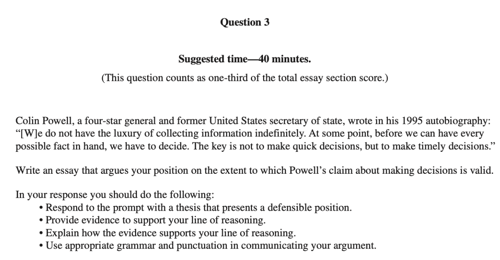AP English Language and Composition
Learn all about the course and exam. Already enrolled? Join your class in My AP.

Not a Student?
Go to AP Central for resources for teachers, administrators, and coordinators.
About the Exam
The AP English Language and Composition Exam will test your understanding of the concepts covered in the course units, as well as your ability to analyze texts and develop written arguments.
This is a fully digital exam. You’ll complete multiple-choice and free-response questions in the Bluebook testing app, with all responses automatically submitted at the end of the exam.
New for 2024-25: MCQs Will Have Four Answer Choices
Starting in the 2024-25 school year, AP English Language and Composition multiple-choice questions (MCQs) will have four answer choices instead of five. This change will take effect with the 2025 exam. All resources have been updated to reflect this change.
Wed, May 14, 2025
AP English Language and Composition Exam
This is the regularly scheduled date for the AP English Language and Composition Exam.
Exam Components
Section 1: multiple choice.
45 questions 45% of Score
Excerpts from nonfiction texts are accompanied by several multiple-choice questions:
- 23–25 Reading questions: You’ll be asked to read and analyze nonfiction texts.
- 20–22 Writing questions: You’ll be asked to read like a writer and consider revisions to the text.
Section 2: Free Response
3 questions 55% of Score
The 2 hour and 15 minute time limit for this section includes a 15-minute reading period.
In the free-response section, you’ll respond to three questions with written answers. This section tests your skill in composition in three areas:
- Synthesis: After reading 6 texts about a topic (including visual and quantitative sources), you will compose an argument that combines and cites at least 3 of the sources to support your thesis.
- Rhetorical analysis: You will read a nonfiction text and analyze how the writer’s language choices contribute to the intended meaning and purpose of the text.
- Argument: You will create an evidence-based argument that responds to a given topic.
Exam Essentials
Exam preparation, ap classroom resources.
Once you join your AP class section online, you’ll be able to access AP Daily videos, any assignments from your teacher, and your assignment results in AP Classroom. Sign in to access them.
- Go to AP Classroom
Free-Response Questions and Scoring Information
Go to AP Central to review free-response questions and scoring information from past exams.
AP English Language and Composition Course and Exam Description
This is the core document for the course. It clearly lays out the course content and describes the exam and AP Program in general.
Services for Students with Disabilities
Students with documented disabilities may be eligible for accommodations for the through-course assessment and the end-of-course exam. If you’re using assistive technology and need help accessing the PDFs in this section in another format, contact Services for Students with Disabilities at 212-713-8333 or by email at [email protected] . For information about taking AP Exams, or other College Board assessments, with accommodations, visit the Services for Students with Disabilities website.
Credit and Placement
Search AP Credit Policies
Find colleges that grant credit and/or placement for AP Exam scores in this and other AP courses.
Additional Information
AP English Language and Composition
Ap english language and composition course and exam description.
This is the core document for the course.
New for 2024-25: MCQs Will Have Four Answer Choices
Starting in the 2024-25 school year, AP English Language and Composition multiple-choice questions (MCQs) will have four answer choices instead of five. This change will take effect with the 2025 exam. All resources have been updated to reflect this change.
Course Overview
AP English Language and Composition is an introductory college-level composition course. Students cultivate their understanding of writing and rhetorical arguments through reading, analyzing, and writing texts as they explore topics like rhetorical situation, claims and evidence, reasoning and organization, and style.
Course and Exam Description
This is the core document for this course. Unit guides clearly lay out the course content and skills and recommend sequencing and pacing for them throughout the year.
Course Resources
Ap english language and composition course overview.
This resource provides a succinct description of the course and exam.
AP English Language and Composition Course and Exam Description Walk-Through
Learn more about the CED in this interactive walk-through.
AP English Language and Composition Course at a Glance
Excerpted from the AP English Language and Composition Course and Exam Description, the Course at a Glance document outlines the topics and skills covered in the AP English Language and Composition course, along with suggestions for sequencing.
The Difference Between AP English Language and Composition and AP English Literature and Composition
Learn the similarities and differences between these two courses and exams.
Course Content
The course skills are organized within nine units that scaffold student development of the analysis and composition skills required for college credit. For each unit, the teacher selects a theme or topic and then chooses texts, typically short nonfiction pieces, that enable students to practice and develop the reading and writing skills for that unit. This course framework provides a description of what students should know and be able to do to qualify for college credit or placement. Teachers have the flexibility to organize the course content as they like.
Course Skills
The updated AP English Language and Composition framework included in the course and exam description outlines distinct skills that students should practice throughout the year—skills that will help them learn to think and act like writers.
| 1. Rhetorical Situation: Reading | Explain how writers’ choices reflect the components of the rhetorical situation. | 11%–14% |
| 2. Rhetorical Situation: Writing | Make strategic choices in a text to address a rhetorical situation. | 11%–14% |
| 3. Claims and Evidence: Reading | Identify and describe the claims and evidence of an argument. | 13%–16% |
| 4. Claims and Evidence: Writing | Analyze and select evidence to develop and refine a claim. | 11%–14% |
| 5. Reasoning and Organization: Reading | Describe the reasoning, organization, and development of an argument. | 13%–16% |
| 6. Reasoning and Organization: Writing | Use organization and commentary to illuminate the line of reasoning in an argument. | 11%–14% |
| 7. Style: Reading | Explain how writers’ stylistic choices contribute to the purpose of an argument. | 11–14% |
| 8. Style: Writing | Select words and use elements of composition to advance an argument. | 11–14% |
AP and Higher Education
Higher education professionals play a key role in developing AP courses and exams, setting credit and placement policies, and scoring student work. The AP Higher Education section features information on recruitment and admission, advising and placement, and more.
This chart shows recommended scores for granting credit, and how much credit should be awarded, for each AP course. Your students can look up credit and placement policies for colleges and universities on the AP Credit Policy Search .
Meet the AP English Language and Composition Development Committee
The AP Program is unique in its reliance on Development Committees. These committees, made up of an equal number of college faculty and experienced secondary AP teachers from across the country, are essential to the preparation of AP course curricula and exams.
AP English Language and Composition Development Committee
What are your chances of acceptance?
Calculate for all schools, your chance of acceptance.
Your chancing factors
Extracurriculars.
How to Write the AP Lang Synthesis Essay + Example
Do you know how to improve your profile for college applications.
See how your profile ranks among thousands of other students using CollegeVine. Calculate your chances at your dream schools and learn what areas you need to improve right now — it only takes 3 minutes and it's 100% free.
Show me what areas I need to improve
What’s Covered:
What is the ap lang synthesis essay, how will ap scores affect my college chances.
AP English Language and Composition, commonly known as AP Lang, is one of the most engaging and popular AP classes offered at most high schools, with over 535,000 students taking the class . AP Lang tests your ability to analyze written pieces, synthesize information, write rhetorical essays, and create cohesive and concrete arguments. However, the class is rather challenging as only 62% of students were able to score a three or higher on the exam.
The AP Lang exam has two sections. The first consists of 45 multiple choice questions which need to be completed in an hour. This portion counts for around 45% of your total score. These questions ask students to analyze written pieces and answer questions related to each respective passage. All possible answer choices can be found within the text, and no prior knowledge of literature is needed to understand the passages.
The second section contains three free-response questions to be finished in under two hours and 15 minutes. This section counts for 55% of your score and includes the synthesis essay, the rhetorical essay, and the argumentative essay.
- The synthesis essay requires you to read 6-7 sources and create an argument using at least three sources.
- The rhetorical analysis essay requires you to describe how a piece of writing evokes specific meanings and symbolism.
- The argumentative essay requires you to pick a perspective of a debate and create an argument based on the evidence provided.
In this post, we will take a look at the AP Lang synthesis essay and discuss tips and tricks to master this part of the exam. We will also provide an example of a well-written essay for review.
The AP Lang synthesis essay is the first of three essays included in the Free Response section of the AP Lang exam. The exam presents 6-7 sources that are organized around a specific topic, with two of those sources purely visual, including a single quantitative source (like a graph or pie chart). The remaining 4-5 sources are text-based, containing around 500 words each. It’s recommended that students spend an hour on this essay—15 minute reading period, 40 minutes writing, and 5 minutes of spare time to check over work.
Each synthesis essay has a topic that all the sources will relate to. A prompt will explaining the topic and provide some background, although the topics are usually broad so you will probably know something related to the issue. It will also present a claim that students will respond to in an essay format using information from at least three of the provided sources. You will need to take a stance, either agreeing or disagreeing with the position provided in the claim.
According to the CollegeBoard, they are looking for essays that “combine different perspectives from sources to form a support of a coherent position.” This means that you must state your claim on the topic and highlight relationships between several sources that support your specific position on the topic. Additionally, you’ll need to cite clear evidence from your sources to prove your point.
The synthesis essay counts for six points on the AP Lang exam. Students can receive 0-1 points for writing a thesis statement, 0-4 based on the incorporation of evidence and commentary, and 0-1 points based on the sophistication of thought and demonstration of complex understanding.
While this essay seems extremely overwhelming, considering there are a total of three free-response essays to complete, with proper time management and practiced skills, this essay is manageable and straightforward. In order to enhance the time management aspect of the test to the best of your ability, it is essential to divide the essay up into five key steps.
Step 1: Analyze the Prompt
As soon as the clock starts, carefully read and analyze what the prompt asks from you. It might be helpful to markup the text to identify the most critical details. You should only spend around 2 minutes reading the prompt so you have enough time to read all the sources and figure out your argument. Don’t feel like you need to immediately pick your stance on the claim right after reading the prompt. You should read the sources before you commit to your argument.
Step 2: Read the Sources Carefully
Although you are only required to use 3 of the 6-7 sources provides, make sure you read ALL of the sources. This will allow you to better understand the topic and make the most educated decision of which sources to use in your essay. Since there are a lot of sources to get through, you will need to read quickly and carefully.
Annotating will be your best friend during the reading period. Highlight and mark important concepts or lines from each passage that would be helpful in your essay. Your argument will probably begin forming in your head as you go through the passages, so you will save yourself a lot of time later on if you take a few seconds to write down notes in the margins. After you’ve finished reading a source, reflect on whether the source defends, challenges, or qualifies your argument.
You will have around 13 minutes to read through all the sources, but it’s very possible you will finish earlier if you are a fast reader. Take the leftover time to start developing your thesis and organizing your thoughts into an outline so you have more time to write.
Step 3: Write a Strong Thesis Statement
In order to write a good thesis statement, all you have to do is decide your stance on the claim provided in the prompt and give an overview of your evidence. You essentially have three choices on how to frame your thesis statement: You can defend, challenge or qualify a claim that’s been provided by the prompt.
- If you are defending the claim, your job will be to prove that the claim is correct .
- If you are challenging the claim, your job will be to prove that the claim is incorrect .
- If you choose to qualify the claim, your job will be to agree to a part of the claim and disagree with another part of the claim.
A strong thesis statement will clearly state your stance without summarizing the issue or regurgitating the claim. The CollegeBoard is looking for a thesis statement that “states a defensible position and establishes a line of reasoning on the issue provided in the prompt.”
Step 4: Create a Minimal Essay Outline
Developing an outline might seem like a waste of time when you are up against the clock, but believe us, taking 5-10 minutes to outline your essay will be much more useful in the long run than jumping right into the essay.
Your outline should include your thesis statement and three main pieces of evidence that will constitute each body paragraph. Under each piece of evidence should be 2-3 details from the sources that you will use to back up your claim and some commentary on how that evidence proves your thesis.
Step 5: Write your Essay
Use the remaining 30-35 minutes to write your essay. This should be relatively easy if you took the time to mark up the sources and have a detailed outline. Remember to add special consideration and emphasis to the commentary sections of the supporting arguments outlined in your thesis. These sentences are critical to the overall flow of the essay and where you will be explaining how the evidence supports or undermines the claim in the prompt.
Also, when referencing your sources, write the in-text citations as follows: “Source 1,” “Source 2,” “Source 3,” etc. Make sure to pay attention to which source is which in order to not incorrectly cite your sources. In-text citations will impact your score on the essay and are an integral part of the process.
After you finish writing, read through your essay for any grammatical errors or mistakes before you move onto the next essay.
Here are six must-have tips and tricks to get a good score on the synthesis essay:
- Cite at least four sources , even though the minimum requirement is three. Remember not to plagiarize and cite everything you use in your arguments.
- Make sure to develop a solid and clear thesis . Develop a stable stance for the claim and stick with it throughout the entire paper.
- Don’t summarize the sources. The summary of the sources does not count as an argument.
- You don’t necessarily have to agree with the sources in order to cite them. Using a source to support a counterargument is still a good use of a source.
- Cite the sources that you understand entirely . If you don’t, it could come back to bite you in the end.
- Use small quotes , do not quote entire paragraphs. Make sure the quote does not disrupt the flow or grammar of the sentence you write.

Discover your chances at hundreds of schools
Our free chancing engine takes into account your history, background, test scores, and extracurricular activities to show you your real chances of admission—and how to improve them.
Here is an example prompt and essay from 2019 that received 5 of the 6 total points available:
In response to our society’s increasing demand for energy, large-scale wind power has drawn attention from governments and consumers as a potential alternative to traditional materials that fuel our power grids, such as coal, oil, natural gas, water, or even newer sources such as nuclear or solar power. Yet the establishment of large-scale, commercial-grade wind farms is often the subject of controversy for a variety of reasons.
Carefully read the six sources, found on the AP English Language and Composition 2019 Exam (Question 1), including the introductory information for each source. Write an essay that synthesizes material from at least three of the sources and develops your position on the most important factors that an individual or agency should consider when deciding whether to establish a wind farm.
Source A (photo)
Source B (Layton)
Source C (Seltenrich)
Source D (Brown)
Source E (Rule)
Source F (Molla)
In your response you should do the following:
- Respond to the prompt with a thesis presents a defensible position.
- Select and use evidence from at least 3 of the provided sources to support your line of reasoning. Indicate clearly the sources used through direct quotation, paraphrase, or summary. Sources may be cited as Source A, Source B, etc., or by using the description in parentheses.
- Explain how the evidence supports your line of reasoning.
- Use appropriate grammar and punctuation in communicating your argument.
[1] The situation has been known for years, and still very little is being done: alternative power is the only way to reliably power the changing world. The draw of power coming from industry and private life is overwhelming current sources of non-renewable power, and with dwindling supplies of fossil fuels, it is merely a matter of time before coal and gas fuel plants are no longer in operation. So one viable alternative is wind power. But as with all things, there are pros and cons. The main factors for power companies to consider when building wind farms are environmental boon, aesthetic, and economic factors.
[2] The environmental benefits of using wind power are well-known and proven. Wind power is, as qualified by Source B, undeniably clean and renewable. From their production requiring very little in the way of dangerous materials to their lack of fuel, besides that which occurs naturally, wind power is by far one of the least environmentally impactful sources of power available. In addition, wind power by way of gearbox and advanced blade materials, has the highest percentage of energy retention. According to Source F, wind power retains 1,164% of the energy put into the system – meaning that it increases the energy converted from fuel (wind) to electricity 10 times! No other method of electricity production is even half that efficient. The efficiency and clean nature of wind power are important to consider, especially because they contribute back to power companies economically.
[3] Economically, wind power is both a boon and a bone to electric companies and other users. For consumers, wind power is very cheap, leading to lower bills than from any other source. Consumers also get an indirect reimbursement by way of taxes (Source D). In one Texan town, McCamey, tax revenue increased 30% from a wind farm being erected in the town. This helps to finance improvements to the town. But, there is no doubt that wind power is also hurting the power companies. Although, as renewable power goes, wind is incredibly cheap, it is still significantly more expensive than fossil fuels. So, while it is helping to cut down on emissions, it costs electric companies more than traditional fossil fuel plants. While the general economic trend is positive, there are some setbacks which must be overcome before wind power can take over as truly more effective than fossil fuels.
[4] Aesthetics may be the greatest setback for power companies. Although there may be significant economic and environmental benefit to wind power, people will always fight to preserve pure, unspoiled land. Unfortunately, not much can be done to improve the visual aesthetics of the turbines. White paint is the most common choice because it “[is] associated with cleanliness.” (Source E). But, this can make it stand out like a sore thumb, and make the gargantuan machines seem more out of place. The site can also not be altered because it affects generating capacity. Sound is almost worse of a concern because it interrupts personal productivity by interrupting people’s sleep patterns. One thing for power companies to consider is working with turbine manufacturing to make the machines less aesthetically impactful, so as to garner greater public support.
[5] As with most things, wind power has no easy answer. It is the responsibility of the companies building them to weigh the benefits and the consequences. But, by balancing economics, efficiency, and aesthetics, power companies can create a solution which balances human impact with environmental preservation.
More examples can be found here at College Board.
While AP Scores help to boost your weighted GPA, or give you the option to get college credit, AP Scores don’t have a strong effect on your admissions chances . However, colleges can still see your self-reported scores, so you might not want to automatically send scores to colleges if they are lower than a 3. That being said, admissions officers care far more about your grade in an AP class than your score on the exam.

Related CollegeVine Blog Posts


Choose Your Test
- Search Blogs By Category
- College Admissions
- AP and IB Exams
- GPA and Coursework
Expert Guide to the AP Language and Composition Exam
Advanced Placement (AP)

With the 2023 AP English Language and Composition exam happening on Tuesday, May 9, it's time to make sure that you're familiar with all aspects of the exam. In this article, I'll give a brief overview of the test, do a deeper dive on each of the sections, discuss how the exam is scored, offer some strategies for studying, and finally wrap up with some essential exam day tips.
Exam Overview
The AP Language and Composition exam tests your rhetorical and composition skills. Essentially, how do authors construct effective arguments in their writing? What tools do they use? How can you use those tools to craft effective writing yourself? That is the essence of rhetorical analysis.
The exam has two parts: the first section is an hour-long, 45 question multiple-choice section. It includes five sets of questions, each based on a passage or passages. In this section, there will be 23-25 rhetorical analysis questions which test your rhetorical skills. There will also be 20-22 writing questions which require you to consider revisions to the texts you're shown.
The second section is free response. It starts with a 15-minute reading period, and then you'll have 120 minutes to write three analytical essays:
- One essay where you synthesize several provided texts to create an argument
- One essay where you analyze a nonfiction passage for its rhetorical construction
- One essay where you create an original argument in response to a prompt.
You will have about 40 minutes to write each essay, but no one will prompt you to move from essay to essay—you can structure the 120 minutes as you wish.
In the next sections I'll go over each section of the exam more closely—first multiple choice, and then free response.
The AP English Language and Composition Multiple-Choice
The multiple-choice section tests you on two main areas. The first is how well you can read and understand nonfiction passages for their use of rhetorical devices and tools. The second is how well you can "think like a writer" and make revisions to texts in composition questions.
You will be presented with five passages, about which you will receive a small amount of orienting information, e.g. "This passage is excerpted from a collection of essays on boating" or "This passage is excerpted from an essay written in 19th-century Haiti." Each passage will be followed by a set of questions.
There are, in general, eight question types you can expect to encounter on the multiple-choice section of the exam. I've taken my examples from the sample questions in the " Course and Exam Description ."

Magic eight-ball says there are eight types of multiple-choice questions!
Type 1: Reading Comprehension
These questions are focused on verifying that you understood what a certain part of the passage was saying on a concrete, literal level. You can identify these questions from phrases like "according to" "refers," etc. The best way to succeed on these questions is to go back and re-read the part of the passage referred to very carefully.

Type 2: Implication
These questions take reading comprehension one step further—they are primarily focused on what the author is implying without directly coming out and saying it. These questions will have a correct answer, though, based on evidence from the passage. Which interpretation offered in the answers does the passage most support? You can identify questions like these from words like "best supported," ‘"implies," "suggests," "inferred," and so on.

Type 3: Overall Passage and Author Questions
These questions ask about overall elements of the passage or the author, such as the author's attitude on the issue discussed, the purpose of the passage, the passage's overarching style, the audience for the passage, and so on.
You can identify these questions because they won't refer back to a specific moment in the text. For these questions, you'll need to think of the passage from a "bird's-eye view" and consider what all of the small details together are combining to say.

Type 4: Relationships Between Parts of the Text
Some questions will ask you to describe the relationship between two parts of the text, whether they are paragraphs or specific lines. You can identify these because they will usually explicitly ask about the relationship between two identified parts of the text, although sometimes they will instead ask about a relationship implicitly, by saying something like "compared to the rest of the passage."

Type 5: Interpretation of Imagery/Figurative Language
These questions will ask you about the deeper meaning or implication of figurative language or imagery that is used in the text. Essentially, why did the author choose to use this simile or this metaphor? What is s/he trying to accomplish?
You can generally identify questions like this because the question will specifically reference a moment of figurative language in the text. However, it might not be immediately apparent that the phrase being referenced is figurative, so you may need to go back and look at it in the passage to be sure of what kind of question you are facing.

Type 6: Purpose of Part of the Text
Still other questions will ask you to identify what purpose a particular part of the text serves in the author's larger argument. What is the author trying to accomplish with the particular moment in the text identified in the question?
You can identify these questions because they will generally explicitly ask what purpose a certain part of the text serves. You may also see words or phrases like "serves to" or "function."

Type 7: Rhetorical Strategy
These questions will ask you to identify a rhetorical strategy used by the author. They will often specifically use the phrase "rhetorical strategy," although sometimes you will be able to identify them instead through the answer choices, which offer different rhetorical strategies as possibilities.

Type 8: Composition
This is the newest question type, first seen in the 2019/2020 school year. For these questions, the student will need to act as though they are the writer and think through different choices writers need to make when writing or revising text.
These questions can involve changing the order of sentences or paragraphs, adding or omitting information to strengthen an argument or improve clarity, making changes to draw reader attention, and other composition-based choices.

Some very important stylish effects going on here.
The AP English Language and Composition Free Response
The free response section has a 15-minute reading period. After that time, you will have 120 minutes to write three essays that address three distinct tasks.
Because the first essay involves reading sources, it is suggested that you use the entire 15-minute reading period to read the sources and plan the first essay. However, you may want to glance at the other questions during the reading period so that ideas can percolate in the back of your mind as you work on the first essay.
Essay One: Synthesis
For this essay, you will be briefly oriented on an issue and then given anywhere from six to seven sources that provide various perspectives and information on the issue. You will then need to write an argumentative essay with support from the documents.
If this sounds a lot like a DBQ , as on the history AP exams, that's because it is! However, this essay is much more argumentative in nature—your goal is to persuade, not merely interpret the documents.
Example (documents not included, see 2022 free response questions ):

Essay Two: Rhetorical Analysis
In the second essay, you'll be presented with an excerpt from a nonfiction piece that advances an argument and asked to write an essay analyzing the rhetorical strategies used to construct the passage's argument. You will also be given some orienting information—where the passage was excerpted from, who wrote it, its approximate date, where it was published (if at all), and to whom it was directed.
Example (excerpt not included, see 2022 free response questions ):

Essay Three: Argument
In the third essay, you will be presented with an issue and asked to write a persuasive essay taking a position on the issue. You will need to support your position with evidence from your "reading, experience, and observations."

This doesn't look like a very well-constructed argument.
How The AP Language and Composition Exam Is Scored
The multiple-choice section of the exam is worth 45% of your score, and the free-response section is worth the other 55%. So each of the three free-response essays is worth about 18% of your score.
As on other APs, your raw score will be converted to a scaled score of 1-5. This exam has a relatively low 5 rate. Only 10% of test takers received a 5 in 2022 , although 56% of students received a score of 3 or higher.
In terms of how the raw score is obtained, the multiple-choice section is similar to other AP multiple-choice sections: you receive a point for every question you answer correctly, and there is no penalty for guessing.
The grading rubrics for the free-response questions were revamped in 2019. They are scored using analytic rubrics instead of holistic rubrics. For each free-response question, you will be given a score from 0-6. The rubrics assess three major areas:
#1: Thesis (0 to 1 points): Is there a thesis, and does it properly respond to the prompt?
#2: Evidence and Commentary (0 to 4 points): Does the essay include supporting evidence and analysis that is relevant, specific, well organized, and supports the thesis?
#3: Sophistication (0 to 1 points): Is the essay well-crafted and does it show a sufficiently nuanced understanding of the prompt?
Each scoring rubric broadly assesses these three factors. However, each task is also different in nature, so the rubrics do have some differences. I'll go over each rubric—and what it really means—for you here.
Synthesis Essay Rubrics
| 0 | For any of the following: | |
| 1 |
EVIDENCE AND COMMENTARY
| 0 | ||
| 1 | AND | |
| 2 | AND | |
| 3 | AND | |
| 4 | AND |
SOPHISTICATION
| 0 | ||
| 1 | Responses that earn this point may demonstrate sophistication of thought and/or a complex understanding of the rhetorical situation by doing any of the following: |

Time to synthesize this dough into some cookies.
Rhetorical Analysis Essay Rubrics
| 0 | ||
| 1 | AND | |
| 2 | AND | |
| 3 | AND AND | |
| 4 | AND AND |

Examine your texts closely!
Argumentative Essay Rubrics

The best kind of frenzy is a puppy frenzy!
AP English Language Prep Tips
Unlike its cousin, the AP English Literature and Composition exam, the AP Language and Composition exam (and course) have very little to do with fiction or poetry. So some students used to more traditional English classes may be somewhat at a loss as to what to do to prepare.
Luckily for you, I have a whole slate of preparation tips for you!
Read Nonfiction—In a Smart Way
A major thing you can do to prepare for the AP Lang and Comp exam is to read nonfiction— particularly nonfiction that argues a position , whether explicitly (like an op-ed) or implicitly (like many memoirs and personal essays). Read a variety of non-fiction genres and topics, and pay attention to the following:
- What is the author's argument?
- What evidence do they use to support their position?
- What rhetorical techniques and strategies do they use to build their argument?
- Are they persuasive? What counterarguments can you identify? Do they address them?
Thinking about these questions with all the reading you do will help you hone your rhetorical analysis skills.
Learn Rhetorical Terms and Strategies
Of course, if you're going to be analyzing the nonfiction works you read for their rhetorical techniques and strategies, you need to know what those are! You should learn a robust stable of rhetorical terms from your teacher, but here's my guide to the most important AP Language and Composition terms .
- We've compiled a list of 20 rhetorical devices you should know.
- A heroic individual from Riverside schools in Ohio uploaded this aggressively comprehensive list of rhetorical terms with examples. It's 27 pages long, and you definitely shouldn't expect to know all of these for the exam, but it's a useful resource for learning some new terms.
- Another great resource for learning about rhetorical analysis and how rhetorical devices are actually used is the YouTube Channel Teach Argument , which has videos rhetorically analyzing everything from Taylor Swift music videos to Super Bowl commercials. It's a fun way to think about rhetorical devices and get familiar with argumentative structures.
- Finally, a great book—which you might already use in your class—is " They Say, I Say. " This book provides an overview of rhetoric specifically for academic purposes, which will serve you well for AP preparation and beyond.
You also need to practice argumentative and persuasive writing. In particular, you should practice the writing styles that will be tested on the exam: synthesizing your own argument based on multiple outside sources, rhetorically analyzing another piece of writing in-depth, and creating a completely original argument based on your own evidence and experience.
You should be doing lots of writing assignments in your AP class to prepare, but thoughtful, additional writing will help. You don't necessarily need to turn all of the practice writing you do into polished pieces, either—just writing for yourself, while trying to address some of these tasks, will give you a low-pressure way to try out different rhetorical structures and argumentative moves, as well as practicing things like organization and developing your own writing style.

Not the most auspicious start to an argumentative essay.
Practice for the Exam
Finally, you'll need to practice specifically for the exam format. There are sample multiple-choice questions in the " AP Course and Exam Description ," and old free-response questions on the College Board website.
Unfortunately, the College Board hasn't officially released any complete exams from previous years for the AP English Language and Composition exam, but you might be able to find some that teachers have uploaded to school websites and so on by Googling "AP Language complete released exams." I also have a guide to AP Language and Composition practice tests .
Once you're prepped and ready to go, how can you do your best on the test?

AP Language and Composition Test Day Tips
Here are four key tips for test-day success.

You are one hundred percent success!
Interact With the Text
When you are reading passages, both on the multiple-choice section and for the first two free-response questions, interact with the text! Mark it up for things that seem important, devices you notice, the author's argument, and anything else that seems important to the rhetorical construction of the text. This will help you engage with the text and make it easier to answer questions or write an essay about the passage.
Think About Every Text's Overarching Purpose and Argument
Similarly, with every passage you read, consider the author's overarching purpose and argument. If you can confidently figure out what the author's primary assertion is, it will be easier to trace how all of the other aspects of the text play into the author's main point.
Plan Your Essays
The single most important thing you can do for yourself on the free-response section of the AP English Language exam is to spend a few minutes planning and outlining your essays before you start to write them.
Unlike on some other exams, where the content is the most important aspect of the essay, on the AP Language Exam, organization, a well-developed argument, and strong evidence are all critical to strong essay scores. An outline will help you with all of these things. You'll be able to make sure each part of your argument is logical, has sufficient evidence, and that your paragraphs are arranged in a way that is clear and flows well.
Anticipate and Address Counterarguments
Another thing you can do to give your free responses an extra boost is to identify counterarguments to your position and address them within your essay. This not only helps shore up your own position, but it's also a fairly sophisticated move in a timed essay that will win you kudos with AP graders.

Address counterarguments properly or they might get returned to sender!
Key Takeaways
The AP Language and Composition exam tests your rhetorical skills. The exam has two sections.
The first section is an hour-long, 45 question multiple-choice test based on the rhetorical techniques and composition choices.
The second section is a two-hour free-response section (with a 15-minute initial reading period) with three essay questions: one where you must synthesize given sources to make an original argument, one where you must rhetorically analyze a given passage, and one where you must create a wholly original argument about an issue with no outside sources given.
You'll receive one point for every correct answer on the multiple-choice section of the exam, which is worth 45% of your score. The free-response section is worth 55% of your score. For each free-response question, you'll get a score based on a rubric from 0-6. Your total raw score will be converted to a scaled score from 1-5.
Here are some test prep strategies for AP Lang:
#1 : Read nonfiction with an eye for rhetoric #2 : Learn rhetorical strategies and techniques #3 : Practice writing to deploy rhetorical skills #4 : Practice for the exam!
Here are some test-day success tips:
#1 : Interact with each passage you encounter! #2 : Consider every text's overarching purpose and argument. #3 : Keep track of time #4 : Plan your essays #5 : Identify and address counterarguments in your essays.
With all of this knowledge, you're ready to slay the AP English Language and Composition beast!

Noble knight, prepare to slay the AP dragon!
What's Next?
Want more AP Lang review? We have a complete collection of released AP Language practice tests , as well as a list of the AP Lang terms you need to know and a guide to the multiple choice section .
Taking the AP Literature exam? Check out our ultimate guide to the AP English Literature test and our list of AP Literature practice tests .
Taking other AP exams? See our Ultimate Guides to AP World History , AP US History , AP Chemistry , AP Biology , AP World History , and AP Human Geography .
Need more AP prep guidance? Check out how to study for AP exams and how to find AP practice tests .

These recommendations are based solely on our knowledge and experience. If you purchase an item through one of our links, PrepScholar may receive a commission.
Trending Now
How to Get Into Harvard and the Ivy League
How to Get a Perfect 4.0 GPA
How to Write an Amazing College Essay
What Exactly Are Colleges Looking For?
ACT vs. SAT: Which Test Should You Take?
When should you take the SAT or ACT?
Get Your Free

Find Your Target SAT Score
Free Complete Official SAT Practice Tests
How to Get a Perfect SAT Score, by an Expert Full Scorer
Score 800 on SAT Math
Score 800 on SAT Reading and Writing
How to Improve Your Low SAT Score
Score 600 on SAT Math
Score 600 on SAT Reading and Writing
Find Your Target ACT Score
Complete Official Free ACT Practice Tests
How to Get a Perfect ACT Score, by a 36 Full Scorer
Get a 36 on ACT English
Get a 36 on ACT Math
Get a 36 on ACT Reading
Get a 36 on ACT Science
How to Improve Your Low ACT Score
Get a 24 on ACT English
Get a 24 on ACT Math
Get a 24 on ACT Reading
Get a 24 on ACT Science
Stay Informed
Get the latest articles and test prep tips!

Ellen has extensive education mentorship experience and is deeply committed to helping students succeed in all areas of life. She received a BA from Harvard in Folklore and Mythology and is currently pursuing graduate studies at Columbia University.
Ask a Question Below
Have any questions about this article or other topics? Ask below and we'll reply!

COMMENTS
Download free-response questions from past AP English Language & Composition exams, along with scoring guidelines, sample responses, and scoring distributions.
45 Questions | 1 hour | 45% of Exam Score. Includes 5 sets of questions: 23–25 Reading questions that ask students to read and analyze nonfiction texts. 20–22 Writing questions that ask students to “read like a writer” and consider revisions to stimulus texts.
Get exam information and free-response questions with sample answers you can use to practice for the AP English Language and Composition Exam.
Explore essential teacher resources for AP English Language and Composition, including course materials, exam details, and course audit information.
The AP Lang synthesis essay is the first of three essays included in the Free Response section of the AP Lang exam. The exam presents 6-7 sources that are organized around a specific topic, with two of those sources purely visual, including a single quantitative source (like a graph or pie chart).
The AP Language and Composition exam tests your rhetorical and composition skills. Essentially, how do authors construct effective arguments in their writing? What tools do they use?